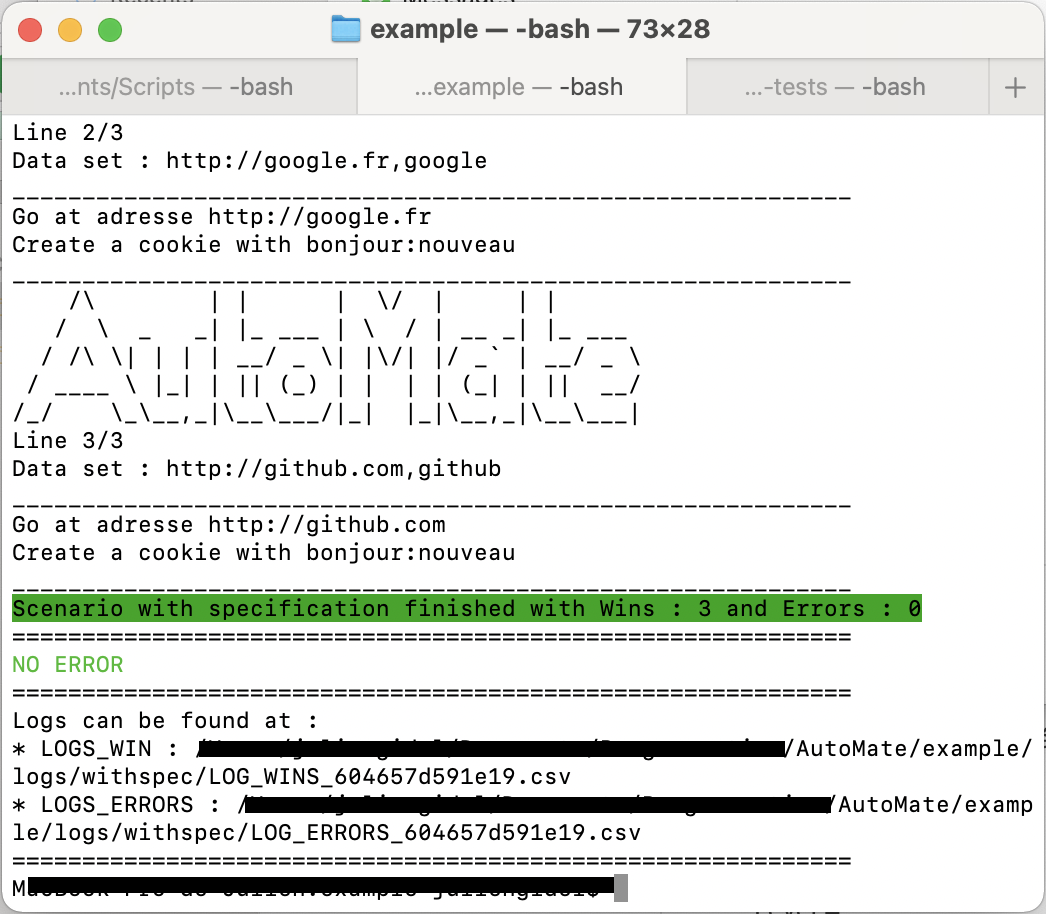jugid / auto-mate
Automation by YAML file
Installs: 17
Dependents: 0
Suggesters: 0
Security: 0
Stars: 6
Watchers: 1
Forks: 0
Open Issues: 0
pkg:composer/jugid/auto-mate
Requires
- lezhnev74/pasvl: ^1.0
- php-webdriver/webdriver: ^1.10
- symfony/config: ^5.2
- symfony/console: ^5.2
- symfony/yaml: ^5.2
Requires (Dev)
- phpstan/phpstan: ^0.12.75
- phpunit/phpunit: ^9
README
AutoMate - Yaml automation library
Release 0.9.0 see the Changelogs
You can get help on the Wiki
Readme summary
Why AutoMate ?
At work, we need to make a lot of management acts. There is already a homemade framework which works well for this kind of actions. The thing is that it takes a long time to develop and create new scenarios. With AutoMate, I tried reducing this wasted time.
With AutoMate you can :
- Create multiple scenarios with multiple commands
- Run them on different browsers
- Configure it as you need
- Inject data into your scenario to use variables in it and repeat the scenario for each dataset
- Get logs from files to know which data was used when the scenario failed/successed
- Have a step by step description written on console
- Add your own commands and plugins thanks to the event system
- Use your own business logic using the logics
- You can use the Launcher class for simple tests and reports.
Getting started
Installation
➡️ Install AutoMate with composer
composer require jugid/auto-mate
➡️ Get a Webdriver
- Chromedriver : Chrome
- Geckodriver : Firefox
- For Safari driver, see Apple docs
➡️ Selenium Grid
You can use Selenium Grid. See Selenium Grid and Selenium Grid 4 Downloads
If you do it, please send a PR with your example and a quick guide.
Usage
To use AutoMate, you first need to :
- Create your yaml configuration file
- Create your scenario file with yaml
- Create some folders corresponding to the scenario
- Maybe create a specification csv file
- Run AutoMate
➡️ Create your yaml configuration file
Your configuration file should looks like this. You MUST prefer using absolute path.
➡️ Create your scenario file with yaml
A scenario is a list of steps that have to be executed by AutoMate. You also can declare variables and the browser to use for this specific scenario. You can find an example here
Your scenario needs to be named
main.yamland saved inscenario_folder/scenario_name/
➡️ Create some folders corresponding to the scenario
Now you have to create some folders corresponding to the scenario you just created.
- logs_folder/scenario_name/ : to log the results in details
- specs_folder/scenario_name/ : to load data in the scenario specification variables scope
➡️ Create your specification file
Specification are csv files that provide data to AutoMate. It will execute the scenario for each lines and load data inside the spec variables scope.
Your specification files need to be saved in specs_folder/scenario_name/my_spec.csv.
Your specification needs to have a header. Otherwise, your variables name will be the data at first line.
You can create the number of specification you want. If AutoMate does not run in Test mode, the spec is renamed with the suffix
_PROCESSEDwhen the scenario run ends. The specification cannot be detected if it has_PROCESSEDin its name.
➡️ Run AutoMate
To run AutoMate, you can use the CLI launcher defined as :
php bin/automate run --scenario=scenario --config=/../config.yaml [--browser=NAME] [--headless] [--server=HTTP_ADRESSE] [--testMode] [--specMode]
or in a shorter way :
php bin/automate run -s scenario -c /../config.yaml [-b NAME] [-h] [-a HTTP_ADRESSE] [-t] [-m]
You can also use the more php way as defined in this example
Visual
This is what AutoMate looks like :
Support
If the website has a robot control, AutoMate cannot be used. If you find a trick, please send a PR.
First, you can find help on the Wiki. Then if you don't find what you want, you can contact us.
Roadmap
See Changelogs for more information
- Tell us your ideas ! You can directly send a PR or open an issue
Will not be implemented
- Specific command to work with tables
Contributing
We love to have your help to make AutoMate better. See CONTRIBUTING.md for more information about contributing and developing AutoMate
License
AutoMate is under MIT License. You can find the license file at License.
Thanks
- php-webdriver for this amazing PHP binding solution
- PASVL from Lezhnev74 for this array validation with patterns that help
- Symfony Config Component
- Badge poser to provide an helper to pimp the README with great badges
If you like AutoMate, do not hesitate to tell us how you love it and if you can, contribute.

